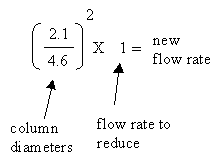|
|
|
|
Calculating the Appropriate Flow Rates for Columns of Differing Diameters or "Maintaining Linear Velocity"
|
|
|
|
|
|
An IonSource.Com mini-tutorial
|
|
|
Introduction The standard size HPLC column (4.6 X 250 mm) is run at a flow rate of 1 mL/min. 4.6 refers to the internal diameter and 250 refers to the length of the HPLC column in millimeters. The limiting factors in choosing a flow rate are, instrument pressure limitations, the effect on the quality of the chromatography, and time. Most HPLC's operate in the pressure range between 30 and 200 bar. Maintaining linear velocity is the single most important factor when trying to reproduce a chromatographic separation on columns of differing diameters. Since flow rate directly impacts HPLC system pressure a discussion of parameters that affect system pressure are listed below.
Stationary
Phase Particle Size Flow Rate
|
|
|
"Maintaining Linear Velocity" |
|
|
. |
|
|
Maintaining mobile phase linear velocity is important when attempting to reproduce chromatography obtained on columns of differing internal diameters. For example to maintain mobile phase linear velocity from the standard column mentioned above, 4.6 X 250 mm, to a small bore column with the dimensions 2.1 X 250 mm one must adjust the flow rate downward by a factor. When going from a 4.6 to a 2.1mm ID or to any smaller ID column decrease the flow rate by the square of the ratios of the column diameters. As mentioned above the standard flow rate for a 4.6 mm column is 1 ml/min. |
|
|
|
|
|
In our example the new flow rate determined for the 2.1 mm column is 0.208 ml/min. Commonly 2.1 mm columns are run at a flow rate of 200 µl/min. It is important to note that sometimes adjustments in mobile phase flow rates from the standard flow rate can have minor beneficial effects in chromatography. Sometimes flowing a column at one half the normal flow rate will have a beneficial effect on a chromatographic separation. |
|
|
. |
|
|
Good Luck. |
|
|
Sincerely, |
|
|
Andrew Guzzetta |
|
| . | |
| . | |

